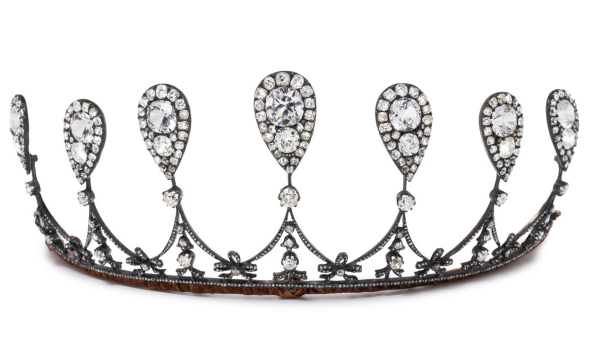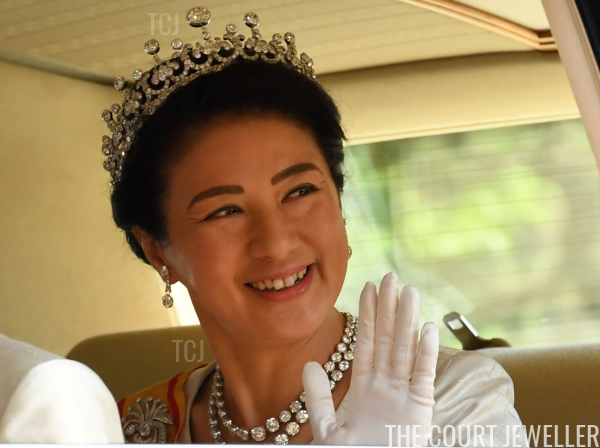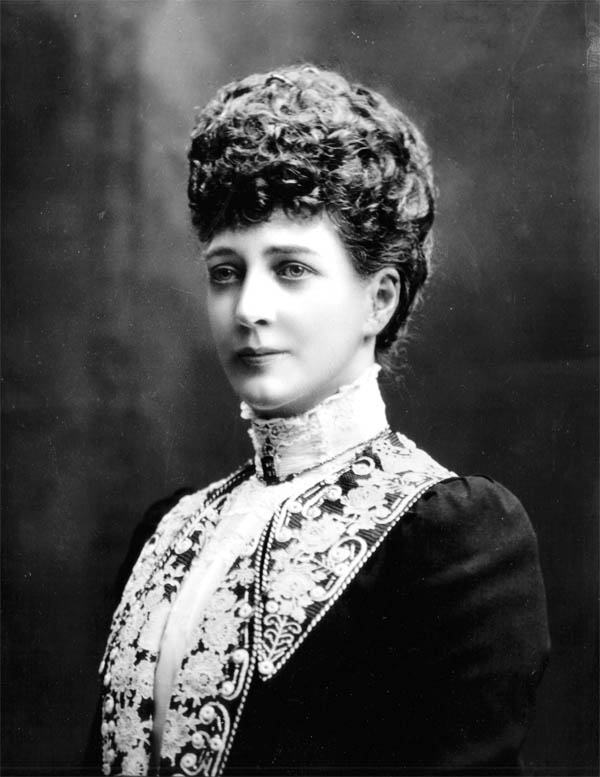 |
| Hindman |
The royal jewelry world has been buzzing for the last few weeks about an upcoming tiara auction. Today, I’ve got all the history—and the sale results!—of the sparkling Radziwill Tiara.
 |
| Hindman |
The nineteenth-century tiara, made of silver and gold, features a bow and festoon base topped by seven pear-shaped diamond-set elements. Each of these pear-shaped toppers features two brilliants surrounded by a cluster of smaller stones. While all of the gems in the tiara were originally diamonds, today the seven largest stones are simulated diamonds, having been replaced by “a previous owner.”
 |
| Hindman |
The first documented owner of the tiara was Princess Dolores Radziwill. She was the Spanish-born wife of Prince Dominik Radziwill, a Polish aristocrat who was descended from the wealthy (and extensive) Radziwill family. Together, Dominik and Dolores restored Balice Castle, a lavish seventeenth-century residence near Krakow. Their aristocratic circle included Archduke Karl Stephan of Austria (a younger brother of Queen Maria Cristina of Spain), who owned a large estate in Żywiec. In January 1909, the two families were united when Dominik and Dolores’s second son, Prince Jerome, married Archduchess Renata, Karl Stephan’s second daughter. Though the Radziwills must have rejoiced at their son’s marriage to a member of the House of Habsburg, Emperor Franz Josef of Austria-Hungary was less thrilled with the alliance. While he consented to the marriage, he also publicly announced that, because the match was not an equal one, Renata would lose her titles and rank and would be shut out of the exclusive Viennese imperial court. It’s not surprising, then, that newspapers reported that the couple’s engagement created “something of a sensation” in courts all over Europe.
 |
| Hindman |
As a wedding gift, Prince Dominik and Princess Dolores offered their new daughter-in-law several pieces of jewelry from the family collection. On her wedding day, Renata wore the diamond tiara with its distinctive seven pear-shaped toppers. Though the auction house that recently sold the tiara highlighted the piece as coming from the House of Habsburg, and it was worn by an archduchess on her wedding day, it’s more correct to note that it has Polish aristocratic roots rather than Austrian imperial heritage.
 |
| Wedding of Prince Dominik and Princess Eugenie, May 1938 |
Renata died in May 1935, three years before her elder son followed in his father’s footsteps and made an impressive marital alliance of his own. The engagement of Prince Dominik, named for his grandfather, to Princess Eugenie of Greece and Denmark was announced in Athens in February 1938. The princess was a first cousin of King George II of the Hellenes, Greece’s much-exiled king, and the daughter of a French imperial princess, Marie Bonaparte. (The couple were distantly connected: Dominik’s uncle, Prince Constantine Radziwill, married to Eugenie’s great-aunt, Louise Blanc [aunt of Princess Marie Bonaparte]. The Blancs are probably best remembered as the owners of the Monte-Carlo Casino.) Dominik and Eugenie were married on May 30, 1938, at the Cathedral of Saint-Louis des Invalides in Paris.
 |
| Wedding of Prince Dominik and Princess Eugenie, May 1938 |
On her wedding day, Princess Eugenie wore the same diamond tiara that her late mother-in-law had worn several decades earlier. The tiara was a gift from her father-in-law, Prince Jerome—or so she thought, anyway. The Radziwill marriage was not a long one. After welcoming two children, Princess Tatiana and Prince George, and subsequently settling in South Africa, the couple divorced in 1946. Shortly afterward, Prince Dominik married again. He and his new young American wife arrived in Cape Town, where he wrote to Princess Eugenie to ask for a key to their bank box to retrieve a pair of cufflinks. She agreed.
According to the New York Daily News, however, Prince Dominik took much more than just his cufflinks. Newspapers offered a list of the pieces he “reclaimed” from the box: “the Habsburg necklace, a double string of diamonds, a tiara of pear-shaped diamonds, a large diamond brooch and a set of emerald jewelry which once had adorned the person of the Empress Maria Theresa of Austria.” (Note that the diamond tiara was on the list.) Betrayed, Princess Eugenie sued him for the return of the pieces, which she argued had been gifts to her from her father-in-law Prince Jerome, who had died in 1945. Prince Dominik claimed that, to the contrary, they’d never been hers at all; instead, he’d inherited them personally from his late mother, and he had merely allowed Eugenie to wear them during their marriage. Ultimately, they settled the matter out of court. The terms of the settlement don’t appear to have been made public, and I don’t know if any of the jewels were returned to Eugenie. (We know that the Habsburg Necklace, which was set with 15 large and 89 small diamonds, was not, as Prince Dominik offered it at auction in Cape Town in 1950. It fetched a much lower price than he’d hoped for.)
 |
| Hindman |
On December 7, the tiara was sold at auction in Chicago by Hindman. We don’t know the identity of the seller, though it’s worth noting that Prince Dominik does have two surviving daughters from his second marriage. But, because we know for certain that Dominik was willing to sell pieces of jewelry during his lifetime, it’s also possible that the present seller doesn’t have any connections to the family at all. Regardless, the tiara seems to have been the beneficiary of the famous “royal bump” at auction. Even though the seven largest “diamonds” in the tiara are indeed paste, the piece significantly exceeded its auction estimate of $6,000-8,000, selling for $68,750.





















